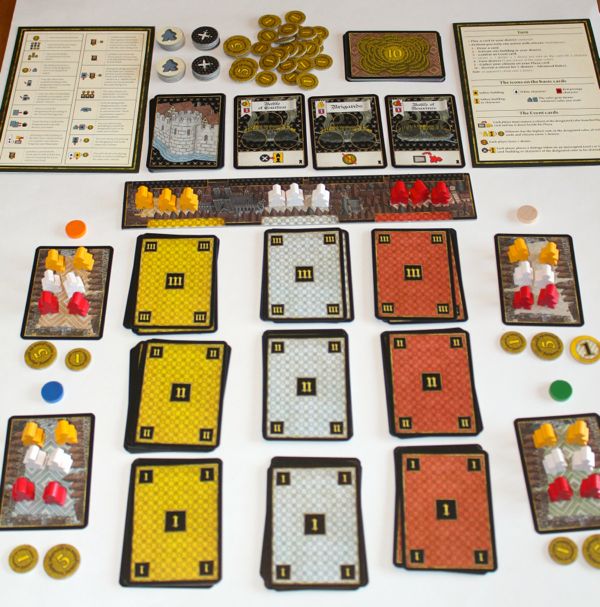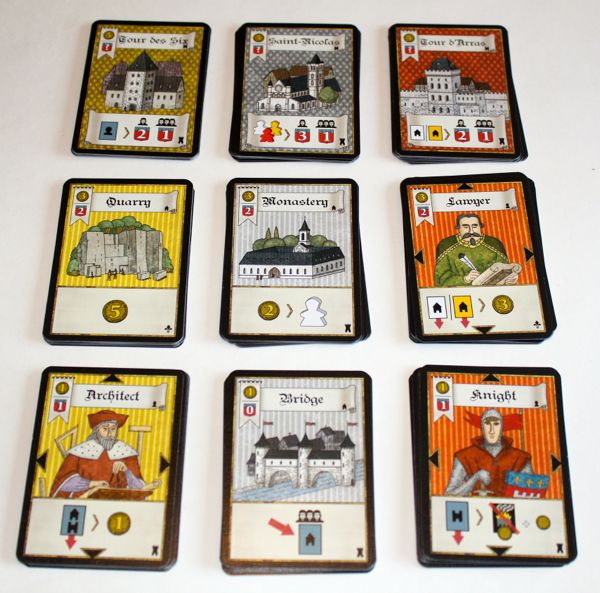Tournay was a Roman city is Belgian Gaul that was destroyed by the Normans back in 881. The game of Tournay has you trying to rebuild the city with cards.
Spoiler alert: It doesn’t feel anything like rebuilding a city when you play, but it’s still fun.
If you are in a hurry and want to check the availability and pricing of Tournay at Amazon, just click here.

How Do You Play Tournay?
Tournay is a worker placement game, which is probably why it doesn’t feel much like you’re building a city.
You can play with 2 to 4 players. The initial setup is something like what is shown below.

The coins, tokens, cards, meeples, small board (on which many of the meeples sit) are all common, public items for everyone to use.
Each player – technically playing orange, blue, nude, or green, as indicated by a small round token – starts with a Plaza card (holding 2 meeples of each color), 6 coins (deniers, but don’t bother calling them that), and a two-sided player aid (see the upper left and upper right of the picture above).
You also “start with” a play area that will hold up to 9 cards in a 3 by 3 grid. Initially, you have no cards, so that area is empty at the beginning of the game.
The I, II, and III level cards in the center are the ones you may add to your personal play area.

There are 4 types of cards. You can see 3 of them above. In the lower two rows are buildings and characters. The top row has prestige buildings. There is 1 Town Crier is each of these 9 decks.
In the upper left of each card is its cost in coins and it victory points, if any. At the bottom of each card is its benefit or special action.
On your turn, you have a handful (maybe a little more) of options. If you have any cards in your hand (you won’t on your first turn), you can play one to your play area (aka your district).
To play it, you must pay the cost and, if any other cards have already been played in your district, you must set it adjacent to one of them within the limits of the 3×3 grid.
Other possible actions are these.
- Draw a card.
- Activate a building.
- Combat an Event card.
- Earn coins.
- Return your citizens to your Plaza.
1) Draw a Card
You use your workers to take a card. The number and color of workers must match the Level number and color of the card.
If you draw a Town Crier card, you trigger the Event cards which are displayed near the top of the initial setup shown above. Event cards are almost all bad, and they affect everyone. This is why you might choose to combat an event (see below).
2) Activate a Building
You can place a worker on a card you have played to make use of its special action. Each of the actions are explained on your player aid and on the back page of the instruction booklet.
3) Combat an Event Card
You can use meeples and coins to remove an event card from the display. You take that card into your hand and can later play the back side of it as a Rampart. A Rampart protects you from future evil Event cards.
4) Earn Coins
You trade one or more of your meeples for 2 coins each.
5) Return Your Citizens to Your Plaza
If you run out of meeple people to play, you take a turn bringing them all back to active status for future turns.
The real kicker in all of this play is that you can use your opponents meeples as if they were yours at the cost of 2 coins per meeple, which you pay to the owner.
The endgame begins either when someone has filled all 9 District spaces with cards, at least 2 of which are prestige buildings, or when one more Town Crier card than the number of players has been flipped over. Each player then gets one more turn.
You then flip over the central meeple board to show the scoring track.

This isn’t really necessary, but it is handy. You use your colored token to move around the track according to the victory points you have collected. (This is the only time the colored token is really needed.)
Prestige buildings are scored a little differently from other cards. Each one is scored for all players who meet the scoring conditions shown on the card. The player who built the card gets the higher number of points (shown under the single person head – see above), and everyone else scores the lower amount (shown under the triple heads).
The player with the most points is the winner.
There is an advanced version of the game with slightly altered rules. There are also expansion cards you can use once you get used the basic cards. Or you can mix and match however you please from the beginning. It’s not that hard of a game to comprehend.
What Kinds of Strategy Are There in Tournay?
It’s hard to imagine how everything works together just from this description of the rules. That’s especially true when you figure in the buying of other players’ workers.
Another aspect that can be important is the arrangement of your cards in your District. This is because the Character cards affect those in the same row or same column as the ones in which they are placed.
Consider this. You need 3 workers of the same color to get a prestige building card. You only own 2 of each color. There are Level I cards that allow you to recruit another worker from the general supply in the central area. Do you try to get one of those, or do you just pay off an opponent to use one of his to complete the triplet?
It’s decisions like these and many others that make Tournay a fun and interesting game to play.
Check for the availability of Tournay at Amazon.
